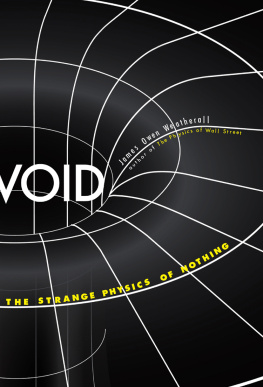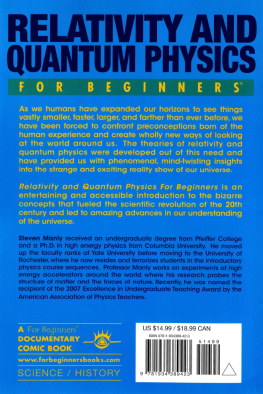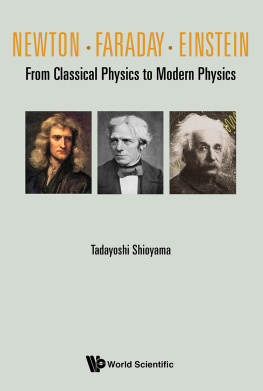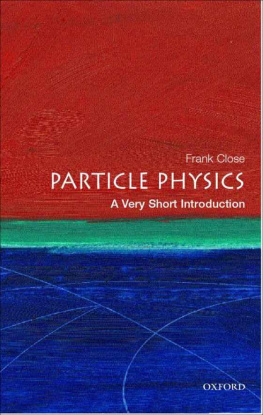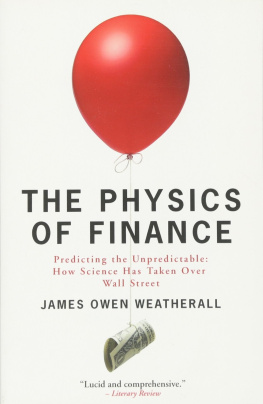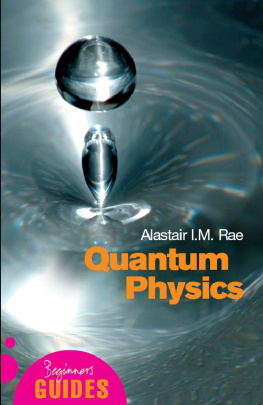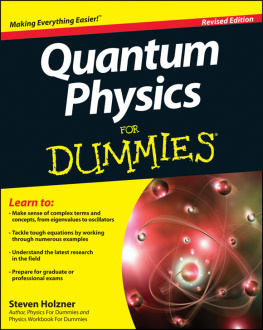FOUNDATIONAL QUESTIONS IN SCIENCE
At its deepest level, science becomes nearly indistinguishable from philosophy. The most fundamental scientific questions address the ultimate nature of the world. Foundational Questions in Science, jointly published by Templeton Press and Yale University Press, invites prominent scientists to ask these questions, describe our current best approaches to the answers, and tell us where such answers may lead: the new realities they point to and the further questions they compel us to ask. Intended for interested lay readers, students, and young scientists, these short volumes show how science approaches the mysteries of the world around us, and offer readers a chance to explore the implications at the profoundest and most exciting levels.

Copyright 2016 by James Owen Weatherall.
All rights reserved.
This book may not be reproduced, in whole or in part, including illustrations, in any form (beyond that copying permitted by Sections 107 and 108 of the U.S. Copyright Law and except by reviewers for the public press), without written permission from the publishers.
Yale University Press books may be purchased in quantity for educational, business, or promotional use. For information, please e-mail sales.press@yale.edu (U.S. office) or sales@yaleup.co.uk (U.K. office).
Designed by Gopa and Ted2, Inc.
Set in Hoefler Text by Gopa and Ted2, Inc.
Printed in the United States of America.
Library of Congress Control Number: 2016949271
ISBN: 978-0-300-20998-3 (cloth: alk. paper)
eISBN: 978-0-30022-449-8
A catalogue record for this book is available from the British Library.
This paper meets the requirements of ANSI/NISO Z39.48-1992
(Permanence of Paper).
10 9 8 7 6 5 4 3 2 1
To Cailin
Contents
Prologue
MUCH ADO ABOUT NOTHING
I MAGINE A HOUSE with no furniture. Is it empty? Presumably I havent given enough information to answer the question. There may be other stuff in the house: people, clothes, food, pets. Take all of this away, too. Indeed, take out all of the stuff, big and small. Mop the floors, scrub the bathroom, and dust the window sills. Now is the house empty?
If this were a book about real estate, the answer would likely be yes. At least, the house would be ready for a new owner to move in. But is it really empty? Perhaps theres a sense in which the rooms are empty, but of course the house still has some things inside. It has walls and floors, pipes and electrical wires, toilets and bathtubs and sinks. Take all of this out, toogut the house completely, imagining, for the sake of argument, that we could do so without the house collapsing. We are left with just a shell of a house. But is it empty?
Of course not. Theres still air inside. And thats not all. If the house is located in a reasonably well-populated town, it is probably near radio towers whose signals reach the house. Perhaps the neighbors have a wireless network with a similar effect. If the house has windows, then during the day it may be filled with sunlight. Radio waves and light rays are kinds of electromagnetic radiation, so there is radiation in the house. And since the house is on the surface of the earth, if one were to drop an apple, say, it would fall to the floor due to the earths gravitational influence. In classical physics, at least, this would be because there is a gravitational field inside the house.
Fine, you think. This is getting a bit pedantic. But we can deal with it. Put the house deep in intergalactic space, far from stars or any other massive bodies. Let the air escape and shield the house from radiation of all sorts. Surely now the house is empty. There is nothing inside. Right?

There is a very old question, famous, or infamous, for its difficulty. Why is there something rather than nothing? For just this sort of reason, many scientifically oriented philosophersnot to mention scientistshave dismissed the question entirely. It makes sense, these philosophers would say, to ask what there is, how it behaves, how we have come to be in the current state of the universe from earlier states. Not why.
We are accustomed to looking to physics for our answers to these latter sorts of questions, at least at the most fundamental level. And indeed, physics has yielded some impressive answers: we now know the material world is composed of such things as quarks and electrons, photons and gluons. The physics of stuff is well-trod territory. But what of the alternative? That is, this approach, of asking what there is and how it behaves, puts all of the emphasis on the something half of the question and ignores the nothing half. What, according to our best physical theories, is nothing? What would the world be like if there were no electrons, no quarks, no photons?
It is this last question that will be the focus of this book. My goal is to explain that if we want to understand stuff, if we want to use physics to study what there is in the world, we need to reckon with what the world would be like if there werent anything at all. I call this the physics of nothing.
The question might seem silly. Nothing, after all, would just be what wed have if there werent any something. In a sense, one might think, no matter what kinds of stuff exists or could exist, the situation if there were nothing would be the same: empty space, pure and simple. This was how the great seventeenth-century physicist Isaac Newton thought about things. He held that space could be thought of as an infinite container into which stuff could be placed or removed without affecting the structure of space itself. It was a kind of theater in which physics would unfold. According to this picture, the physics of nothing is simple.
In fact, this idea may seem so obvious as to pass by without much notice. To say that if we removed all the stuff in the universe, wed be left with empty space doesnt seem like a substantive physical assumptionmuch less one that could be false. But this is as wrong as anything in physics could be.

The twentieth century was a tumultuous time for physics. Centuries-old theories were overturned, first by Einsteins discovery of special and general relativity between 1905 and 1915; then by the development, during the mid-1920s, of quantum theory; and Little was left unscathed by these revolutionseven the physics of nothing.
Indeed, understanding how the physics of nothing has changed with the advent of general relativity and quantum field theory is essential to understanding both what these theories tell us about the world and how dramatically they differ from classical theory.
This book traces these changes. The first chapter picks up at the beginning of modern physics, with the work of the physicist and mathematician Isaac Newton during the seventeenth century. As I explain, Newtons best-known contributions to physics concern his theory of the motion of physical objects, as summarized in the laws of motion that bear his name. His theory of motion still forms the bedrock for a modern physics education, three and a half centuries later. But what is perhaps less well appreciated is that in order to even formulate his laws of motion, Newton needed to redefine fundamental notions of space and time. This led to a radical new picture of what the world is likeand also, what it would be like if there were no stuff in the first place.
One of my emphases here is just how controversial Newtons ideas were at the time. I explain how Newton broke with earlier physicists, such as the Greek philosopher-scientist Aristotle, whose thought dominated European science for millennia, and Ren Descartes, a French physicist, philosopher, and mathematician who strongly influenced Continental science in the early part of the seventeenth century. Much of the chapter is devoted to a famous dispute about the structure of space (and, as it will turn out, time) between Newton and one of his most accomplished contemporaries: Gottfried Willhelm Leibniz, a German polymath and court librarian in Hanover. As we will see, what appears at first glance to be a debate about metaphysics and theology is really tracking very subtle issues about physicsspecifically, what we need to assume about space and time for motion to be the sort of thing that could be governed by laws in the first place.
Next page
